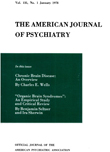A STUDY OF THE ELECTROENCEPHALOGRAM AS RELATED TO PERSONALITY STRUCTURE IN A GROUP OF INMATES OF A STATE PENITENTIARY
Abstract
The data presented above are offered as indications of trends and possibilities in relating EEG types and personality traits. Since the total series comprises records from only 100 cases, it must be confirmed, if possible, by larger (and more well-defined) investigations.
An increase of abnormal EEGs in the prison populations (30%) as compared to that of the normal population has been confirmed.
In the present series EEG abnormalities were found to be equally distributed between crimes of violence and nonviolence. It is possible, however, that more detailed study and observation would have produced some relationship between paroxysmal behavior and paroxysmal EEG record.
An expected positive correlation was found between abnormal EEGs and age at time of EEG test, age at time of first offense, and presence of possible organic brain injury.
Of greater interest is the finding here, as well as in previous investigations, that relatively good personality structure relates to normal EEG. The more stable individuals among the prisoners, those convicted of single crimes, had only 17% abnormal EEG records, and 11% showed Pd profiles on the MMPI, while those who were repeated offenders had 34% abnormal EEGs and 39% had typical Pd profiles.
Fifty percent of the records having high alpha indices occurred in individuals with a high psychopathic deviate score as shown on the MMPI.
If these data are confirmed by further investigation it may eventually be possible, with the assistance of such tests as above, to separate 2 types of transgressors of the law who have reached imprisonment for totally different, almost opposite, reasons and should from every point of view have different treatment. The first of these groups consists of the prisoners who according to the present tests have characteristic MMPI profiles (high Pd peak) and a high incidence of normal EEG records containing much pure alpha activity. Such individuals could be classified psychiatrically as "psychopaths" and because of their fixed personality pattern would require permanent maximal custodial care.
The second group contains mainly those with normal or neurotic profile on the MMPI, and these are found to have a higher incidence of abnormal EEGs. The unstable 4-6/sec. wave-forms and dysrhythmia in their records may indicate an underlying relative instability of personality usually associated with any one of several dynamic categories other than the fixed personality pattern. These subjects, on the other hand, deserve careful therapy, both somatic and psychological, directed at their specific underlying psychopathology.
Access content
To read the fulltext, please use one of the options below to sign in or purchase access.- Personal login
- Institutional Login
- Sign in via OpenAthens
- Register for access
-
Please login/register if you wish to pair your device and check access availability.
Not a subscriber?
PsychiatryOnline subscription options offer access to the DSM-5 library, books, journals, CME, and patient resources. This all-in-one virtual library provides psychiatrists and mental health professionals with key resources for diagnosis, treatment, research, and professional development.
Need more help? PsychiatryOnline Customer Service may be reached by emailing [email protected] or by calling 800-368-5777 (in the U.S.) or 703-907-7322 (outside the U.S.).



